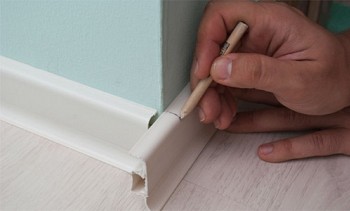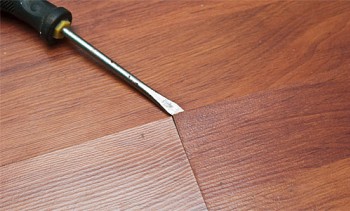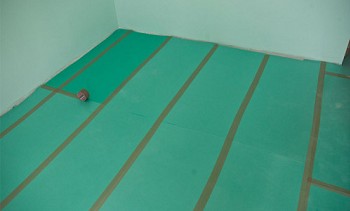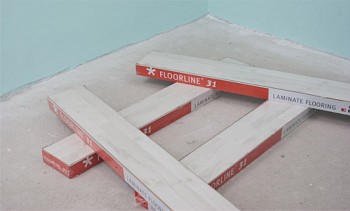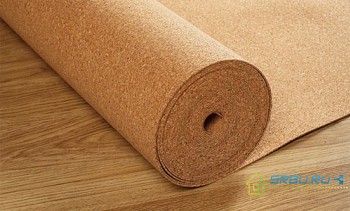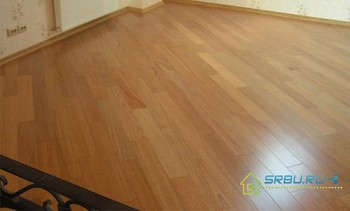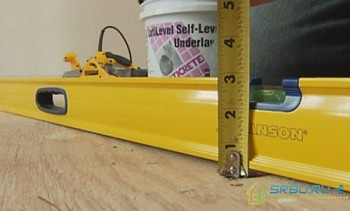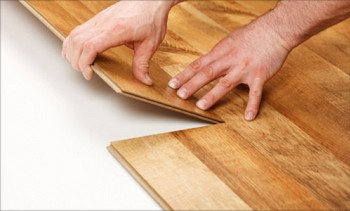For kitchens and bathrooms, a sustainable tile floor is often chosen. The floors in the living rooms are made of warmer materials that create coziness, for example with a laminate. Let's consider how to make a joint of tiles and laminate, depending on its shape and location, so that it does not spoil the interior and is practical.
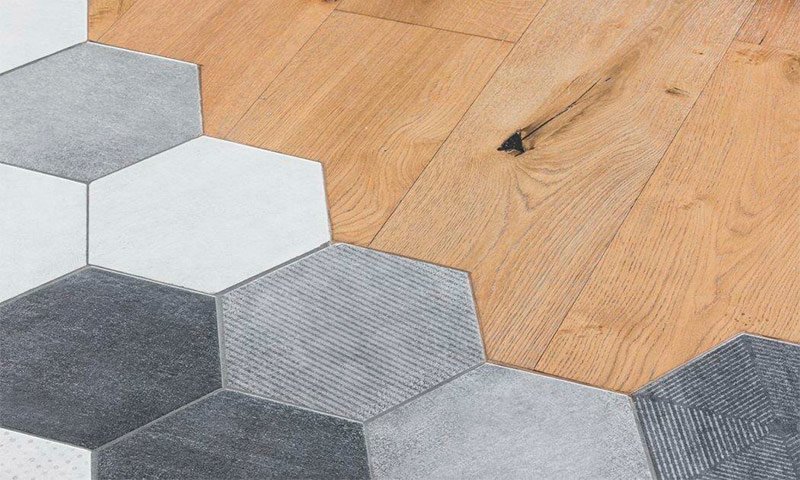
Content:
What factors complicate the joining of tiles and laminate
Depending on the layout of the rooms and the creative idea, it may be necessary to perform a joint of two floor materials in different places. In the case of the classic design of rooms with doors, tiles and laminate will meet exactly under the door frame, which most often needs to be covered with a decorative door sill.
More complicated is the design of the junction on a large area, as is often the case in a studio apartment. There are no partitions that clearly separate the kitchen from other rooms, so the division into zones is carried out conditionally along the line on the floor connecting the two coverings. The difficulty is to do this in harmony with other elements of the interior and is practical for cleaning and moving users.

Different flooring heights
The joint between the tile and the laminate is more difficult to perform beautifully if there are different heights of floor coverings. For example, the tile has a thickness of 8-10 mm and is laid on tile adhesive, which creates a floor height of 12-14 mm. A durable laminate for flooring has a thickness of 8 mm, so even using a special substrate it is impossible to bring the level to the same value.
The difference in joints may be inconvenient for the passage of the site and collect garbage. Removing the laminate flush only at the joining site will contribute to the smooth elevation of the floor, but in this place it will play under load. Therefore, under the laminate, a more stretched screed is made to even out the difference and create a solid base under the coating.
Hygroscopicity of the laminate
Another difficulty in joining a laminate with a tile is the hygroscopicity of the laminate, which affects its structure. If the laminate absorbs moisture, then it will swell and become more loose. To avoid this, first lay the tile and allow the glue to dry. Then the joints of the strips of the laminate are treated with a sealant that seals the places for moisture absorption.
Linear Resizing
Sometimes the physical and mechanical properties of a laminate become a problem in varying sizes under the influence of different temperatures and humidity. With a very tight fit to the tile, this can cause bloating or other deformations. To prevent such a phenomenon, a small gap must be made, providing freedom for expansion.

Material cutting
A common difficulty in joining tiles and laminate is fitting the line. Often in these places a marriage is visible due to a sloppy cut. In the case of short joints under the doors, this is closed by a door sill.

In a large space in a studio apartment, it is important to use an electric jigsaw for a laminate, a grinder with a diamond disk for tiles and a prepared template for cutting out. This will contribute to the evenness and identity of the lines, especially with a wavy seam configuration.
Laminate and tile joint shapes
Depending on the joint location and tile configuration, various forms of joining two floor materials are possible. There are three main types.
Straight line
One of the most common and simple joints. It is made out with or without a threshold.It can be long, in case of dividing the room into zones, or short, located under the door. Even the inexperienced person can cope with the latter option by covering it with a narrow decorative overlay.

Broken line
A very expressive way of joining floor coverings, which involves laying a solid tile (rectangular, diamond-shaped or triangular) without fitting. Laminate walling around repeating the line. But such a performance needs precise cuts and takes more time. The threshold is not used in this case, since it spoils the view. This type of docking looks most advantageous over a long section.

Curved joint
It implies the connection of laminate and tile with a wavy line, which is often realized when moving from the kitchen zone to the living room. Here you will need a professional tool for working with stone and wooden materials, as well as an accurate template. The joint can be made without a nut, if it turned out to make accurate cuts. In the case of wide gaps, they are closed with a wavy patch that repeats the docking line.

Methods for designing joints of laminate and tile without a door
The border between two materials in a long section can be drawn without a nut in different ways. This reduces the cost of the process, and also does not require a special additional tool for fixing.
Using cross-grout
The easiest and cheapest method. The joint of a tile and a laminate without a door is sealed with an inter-seam grout for tiles, available in any specialized store. The color is selected based on the shade of the tiles, laminate and other colors in the room. It can be a fusion of colors or a game in contrast. Application can be done as you lay (if the line is long and this does not occur on the same day) or when both coatings are already laid.

The process is carried out in the following way:
Step 1.
On the semi-base (concrete screed), the future line of material joining is marked with a marker.
Step 2
The first tile is laid so that its edges fit exactly on the intended contour.
Step 3
Laminate is cut to size, and its edges are coated with silicone to block access to moisture.
Step 4
The strips are put in place, taking into account a gap of 3-5 mm.
Step 5
The gap between the two materials is filled with silicone to half the height.
Step 6
When the sealant has dried it is allowed to grout, pushing it deep and without gaps. The received seam is leveled, and the spots soiled nearby are cleaned.
Step 7
At the last stage, the seam is covered with transparent varnish, which will preserve its strength and beautiful appearance.
Installing the expansion joint from the plug
To implement this method of docking acquire a long strip of cork. This material is soft and easily takes a different shape, so it is suitable for both smooth and wavy joints. There are cork strips from 90 to 300 cm in length, and their thickness varies from 7 to 10 mm.

Such an element is called a compensator, because it fills the gaps with itself and compensates for the unevenness of the trim. Due to the soft structure of the cork, it is capable of shrinking and fits easily into narrow sections. With its help it is convenient to mask the small errors of the master. There are products with the upper side varnished or decorated with veneer, which increases the strength and beauty of the product. But you need to take into account that with a long junction (more than 3 m) you will have to buy two compensators and connect them together, and this will be visible to the naked eye.

Compensator installation occurs as follows:
Step 1.
The first tile is laid. Its edge is polished to eliminate protrusions from the hardened glue.
Step 2
The site should be thoroughly cleaned of dust, for which it is effective to use a compressor or vacuum cleaner.
Step 3
Glue is applied along the edge of the tile.
Step 4
If the expansion joint is higher, then it can be trimmed so that it exactly matches the tile. Then it is glued, pressed for a while with your fingers.
Step 5
After that, the laminate spreads, which here can be adjusted closely.To expand it, in case of heating or humidity, the cork will be able to move, due to its soft structure.
Step 6
Between the expansion joint and the laminate, you can carefully fill in the sealant, which will fix the seam.
Using cork sealant
This method is similar to grouting, only it uses a special sealant with cork chips in the composition. The joining of the laminate and tile is carried out using a construction gun, where a tube with a sealant is inserted. This is very convenient for accurately squeezing the substance into the gap.
Cork sealant simplifies installation, as it already has protective components for the laminate that prevent moisture absorption. The seam is elastic and well fills all the bumps caused by uneven cutting. The seam width does not affect the quality. The only downside is the presence of only one color - brown, which does not fit all shades of tile and laminate.

Methods of designing the joints of the laminate and the tile with a doorstep
Making without a nut looks beautiful, but requires experience and precise cut lines. Often this is not possible to achieve this from the first time at home repair with your own hands, and therefore there is a need for a simpler camouflage with an overlay. Such decorative elements, regardless of the material of manufacture and type, are called sills. They are used both in long and short sections.
When sills should be used for a joint
Powder is not only used to mask the uneven cut of a novice master. Sometimes experienced repairmen also resort to this design method.
This is justified in the following situations:
- between the floor materials there is a height difference of up to 10 mm, which cannot be hidden in another way;
- separation of the entrance hall by lowering its level so that debris and dirt from the street are not carried around the house, but are delayed by a ledge;
- zoning of the area by visual and relief separation of the room.
But deciding on this way of registration is worth being prepared for the minuses. Among them: difficult cleaning, accumulation of garbage under the threshold and the ability to catch on it when passing the site.
Varieties of sills and features of their installation
To understand how to close the joint between the tile and the laminate on the floor, you need to study the varieties of thresholds. They are available in different materials and shapes, which affects the ease of installation and configuration of the docking line. Here are the most common solutions.
Aluminum lath
This is a very stylish element for joining on the floor. Its shiny silver surface harmonizes well with gray wood and light tiles. Aluminum has increased strength compared to other materials in this industry, which contributes to a long service life. But with such an overlay, you can only make straight joints, for that the length does not matter: it can be a short transition under the door or a long line between the dining area and the lounge.
Aluminum sills of various shapes are produced in design: flat, T-shaped, L-shaped.

Flat threshold.

T-shaped threshold.

L-shaped docking threshold.

L-shaped sill covering floor edges.
The mounting method can be hidden (when first fixing to the floor and then the decorative top panel is installed) or open (you can see the places of the self-tapping entries).

Hidden threshold mount.

Open mount threshold.
The thickness of the sides can be the same or with an internal difference (at the top the sides are aligned at the same level, and at the bottom they are supported by shelves at different heights), which also helps to draw the border beautifully and safely. Powders can be straight, for joining flooring even in height and curved, for joining flooring with a difference in height. By fastening, the elements are on glue or screws.


Installation with screws is performed as follows:
Step 1.
The purchased nut is trimmed strictly along the length of the joint.
Step 2
Between the tile and the laminate points are outlined to create holes for the dowels.
Step 3
Drill is drilling.
Step 4
The dowels are laid, providing a firm grip of the fasteners in the concrete screed.
Step 5
Coat the inside of the docking element with sealant. This will prevent the accumulation of dust and debris under its edges.
Step 6
The lid is fixed on the screws. To do this, use a screwdriver or screwdriver, but the speed of the latter should be minimal, because it is very easy to bend the aluminum profile.
Self Adhesive Nut
Such linings are made of wood or metal. They can be flat, slightly convex in shape, which smooths the joint well and makes a convenient transition for transporting strollers, toys on wheels, a coffee table, etc. There are also multilevel models for organizing a beautiful height difference with a smooth rise.
The nut is mounted on a self-adhesive base located at the edges from the bottom. It sticks directly to the tiles and laminate, and not to the concrete floor. Models vary in width and length, which simplifies the selection. The color scheme is presented from wenge to bleached oak.

Installation of a self-adhesive nut is performed as follows:
Step 1.
The item is unpacked and cut to the desired size.
Step 2
So that the threshold lies evenly (regardless of the quality of the cut line), you can draw precise marking and orient the edges of the lining along it.
Step 3
The sides of the flooring should be wiped off from dust, as this affects the strength of the joint.
Step 4
The paper layer is removed gradually and the part is applied along the intended contour. You can immediately remove the protective layer, but then the spoils along the entire length will stick and it is more difficult to maintain the evenness of fixation.
Flexible PVC sill
This floor decoration element is made of two parts - the base and the cover, which plays a decorative function. The underside is fixed to the concrete floor or other floor. For this, self-tapping screws (if the base material allows their direct screwing) or a dowel (for a concrete base) are used. The upper mating part snaps into the pressure grooves.

Due to the ability to bend in different directions, the design is well suited for wavy joints of various lengths.

It is available in large sizes and can be for a single-level floor or with a difference. The height difference is up to 10 mm. A variety of shades allows you to choose the right one for any color of tiles and laminate.
Installation of a flexible nut is performed as follows:
Step 1.
A junction line is drawn on the concrete base.
Step 2
Tiles are laid in compliance with the accuracy of the marking edges.
Step 3
The flexible profile of the base is wound under the tile and fixed with screws or dowels.
Step 4
Then the laminate is laid so that its edge is on the border of the lower part of the nut. Its end should be greased with sealant.
Step 5
Lastly, a lid is put on, which is also treated with sealant to prevent debris from accumulating under it. It is inserted into the grooves and latched with a little effort. If clapping with your hand is not enough, you can use a rubber mallet.
Flexible metal profile
These decorative elements are made L-shaped or T-shaped. Due to the numerous slots in the base, the metal is easily bent, so the sills are used for smooth and curved joints. It is convenient to use it to perform complex lines of a combined type that help maintain a stylistic unity.


From above, the metal can be powder coated in any color or remain a natural silver hue. In the case of the L-shaped design, only the laminate is inserted into the groove, and the tile is laid close to the metal without a gap. But to perform such joints you need the same level height, otherwise the transition will not be beautiful.
Let's consider how to make a joint between a laminate and a tile using a flexible profile in stages:
Step 1.
The thickness of each material is measured and, if necessary, the level is increased (substrate, screed).
Step 2
The outline of the future joint is drawn.
Step 3
The profile is cut off and bent in a given shape.
Step 4
The tile is laid and the threshold is mounted in parallel so that its lower plates go under the floor material.
Step 5
The laminate is laid last so that its edge goes under the edge of the nut. This is not difficult to do due to the flexibility of the panels. The butt is pre-lubricated with sealant.
How to choose the right nut
So, we studied all kinds of thresholds for joining laminate and tile, and now it remains to choose the one that is best suited for a particular situation. Here are some tips to help.
1. The purpose of the item. If the sill is used for zoning the space in the combined rooms, then it is worth highlighting, so metal flexible profiles or aluminum are suitable.
2. Material. The aluminum element will last the longest. This is especially true if the house is played with cars, roller skates, or is often vacuum cleaned. Scratches will appear on the plastic, so it takes second place in strength. The tree looks rich, but it is sensitive to moisture, so it is suitable only for offices or bedrooms.
3. The shape of the seam. Direct and short joints are closed by any types of overlays. For wavy or curved lines, only flexible types of metal or PVC are suitable.
4. The method of mounting. In the case of the use of self-tapping screws, they can be open-ended (twisted around the edges of the nut) and hidden (in the inner part, and the lid on the latches is covered on top). Flush mounting is more attractive but time consuming. The easiest way to stack a nut is on a self-adhesive basis. It is performed without a drill and self-tapping screws, which is easier and twice as fast as other methods.
5. Colour.The joint at the junction should be in harmony with the floor covering. For gray shades, similar colors or the metallic sheen of aluminum parts are optimal. If you need to highlight a zone, then you should choose products in the same color, but a couple of shades darker or lighter than the floor. To mask the transition point, manufacturers offer shades identical to the facing materials.
6. Strip width. This parameter depends on the experience of the stacker. Often, the first time it is not possible to perform a tight fit and the gap between the tile and the laminate varies from 2 to 15 mm, which requires a wide nut (20-30 mm). If the gap between the materials is minimal, then it can be decorated with a thin decorative element. In the case of level differences, a narrow threshold will be more noticeable than a wide one.
After determining the method of making the joint between the tile and the laminate, it remains to acquire the necessary materials and tools. It’s good to start installation somewhere in an inconspicuous place to learn the technology and learn how to make beautiful joints.

